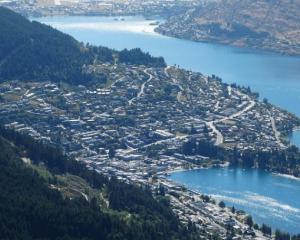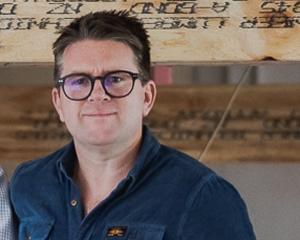
It was the day Queenstown couple Sheena Haywood and Stephen Brent watched as their future home was carried in three parts to its new location at the Ladies Mile.
But this was not just any house.
Now 117 years old, Laurel Bank is breathtaking and for Sheena and Stephen, who won the environmental and heritage category for their work on Laurel Bank in the 2007 Queenstown Lakes District Council Heart of the District Awards, the past two years haven't been without challenges.
Otago Daily Times Queenstown bureau chief Tracey Roxburgh has followed them on their journey.
The first day of the rest of historic homestead Laurel Bank's life, and the beginning of a DIY project to rival most others.
That day, the home, built in 1892, was moved in three parts to Max's Way, off State Highway 6 at the Ladies Mile, and there it began to shine again.
At its original spot at the corner of Frankton Rd and Stanley St, Laurel Bank was once an established guest house - 115 years later it was a graffiti-covered building with holes in almost every wall, where only the brave dared walk across the rotting floor boards.
The site had been purchased by Perron Laurel Ltd, which had been granted consent to establish a 105-room accommodation complex for workers on the section.
However, Laurel Bank - then a decrepit mess - was sitting in the middle of that site.
The plan was to retain part of the house, moving it elsewhere, and demolish the rest. But one Queenstown couple wouldn't hear of it.
Enter Laurel Bank's saviours: Sheena Hayward and Stephen Brent.
The wheels were put in motion in 2006 for the couple to buy the dilapidated house, with plans to transport it to their 2ha property at Max's Way. Two years ago tomorrow, those wheels finally started to move.
One of Queenstown's first commercial accommodation properties, Laurel Bank House originally featured five guest rooms.
This was increased to eight in 1905, when the luxury of a bathroom with hot and cold water was also added.
In the 1920s, Eileen and Harold Overton bought the home, running it as hostel accommodation, closing it at Easter and reopening at Labour Day weekend.
In 1938, the Overtons sold Laurel Bank and it passed through several sets of hands over subsequent years before eventually it was split in two and rented as flats.
For several years it sat abandoned, reportedly home to squatters with no knowledge or appreciation of its significance to the Wakatipu.
Sheena and Stephen had the knowledge and the appreciation but more importantly the passion and the dedication to save it.
Two years ago, it slowly but surely made its way down Frankton Rd -over two days and in three sections - to its new resting place.
The hydraulic trucks tilted constantly as it was lifted over cars, lowered under power lines and manoeuvred across the Lower Shotover Bridge.
The road leading to the section proved too hazardous to negotiate, so the drivers and Sheena and Stephen improvised - rather than following the road, they made a new one.
Sighs of relief were let out when the final section of the house arrived and while the most logistically difficult job was over, the hard part was just beginning for the couple, who had "no budget" and one year to get the exterior of the house, including landscaping, in pristine condition.
By June 2007, the change in Laurel Bank's exterior was phenomenal. A schist gateway, the materials taken from the Arrow River, formed the entrance, with a gravel driveway leading to a car park and the house itself.
Despite scattered tools, scaffolding and mud, the sun was clearly once again shining on Laurel Bank.
The interior was a skeleton, with framework visible at every turn, missing floor boards, Pink Batts hanging down, ladders, wires and cords littering the extensive floor space.
Yet, it was impossible not to be impressed. In the future bathroom, an antique claw-foot bath sat in the middle, with antique fittings which would eventually adorn the room haphazardly leaning against the framework.
Refurbishing the home was no easy feat and many DIY-ers would have run screaming from the prospect, but Sheena and Stephen refused to be intimidated.
Winter was terrible - the couple were still living at their home in Lake Hayes but aware the council's clock was ticking and with the deadline approaching for the completion of the exterior, there was no time to rest.
Antique dealers nationally were scoured for appropriate fittings, including locating 26 cast iron radiators and transporting them from Oamaru Hospital.
Fifteen months on, Sheena and Stephen - who married in September 2007 - had well and truly passed the council-impos-ed deadline for external restoration.
But now the home was a sight to behold. Gone were the holes, boarded-up windows, graffiti, rotting planks of wood and the feeling of unhappy spirits from yesteryear.
Instead sat an elegant home, warm, inviting and prepared to once again stand up to the tests of time.
The kitchen features a large bay window, with the bench top made from 115-year-old wood, which was "part of her", thanks to the efforts of Queenstown Joinery.
The couple toyed with using other timber, but when they found the bench could be made from original Laurel Bank wood, the decision was made.
"She's not a flashy house - she's quite strong and bold. She's pretty, but she's not flashy."
As much of the original walls and floors have been kept where possible, although some of it was "poked".
"We secured a lot of the floor from demo' yards . . . and a house-lot of doors because they were the right kind of style.
"We kept as many originals as we could that weren't ruined."
The formal dining room, off the kitchen, is Sheena's "piece de resistance". Sun streams into the intimate and ornate room through a bay window, an antique mantle surrounds the fireplace, a dining table is set for six, china cabinets line the walls and a turn-of-the-century lamp completes the picture.
"When I first came into the house through the back and climbed around it, I could feel the energy. I lit a lot of incense in here to change the energy and welcome the house.
"The very first time I came in here the door was open and I could not get in the room, there was such a force, an angry force. It needed real . . . love.
"We asked whoever it was hanging around to protect the house [to leave and let us do our job].
"He'll come back from time to time."
The walls of the room had had six layers of wallpaper, dating back to August 1882, and there was newspaper and scrim, but it was stripped back to rough-sawn sarking timber behind.
Newspaper also covered the ceiling and took hours to strip back, but now hanging in the middle is a ceiling rose picked up at a demolition yard in Invercargill.
One of the antique china cabinets has a special place in Sheena's heart - it was a wedding present from her grandfather to her grandmother.
Sitting on the floor is a brass sign, with "Forty Seven" on it - described as a "real find".
Laurel Bank, at 47 Max's Way, was in need of a sign and it was found in an antique store in Christchurch.
In the living room, an antique mantle adorns a modern fireplace - all the fireplaces are built to modern standards but finished with period decoration.
On it sits a black and white photo of Laurel Bank, in the days when she was owned by Harold Overton. Harold's son Robert was integral in the refurbishment of the home, providing details of what used to be where.
The builders and architects pored over that photo, gaining valuable insight into how the front exterior of the house used to look.
For Sheena and Steve, restoring the exterior to as close as possible to its original state was not negotiable.
For example, the four wooden finials - the couple had one, but three more were turned - now adorn the gables.
The living room is an expansive, open-plan area, separated by comfy furniture and includes the informal dining room, more bay windows, and antiques.
The right rear wing of the house is the only part with any remaining evidence of the mess it once was.
While it will eventually contain two bedrooms, it now serves as a home for the graffitied doors, wood and leftover mess from pre-February 2007.
The floor boards in the back are all new - the originals were completely rotten. Replacing them wasn't in the plan, but as Sheena came to understand, plans change.
When complete, the back area will house a television and media room, four guest rooms, a guest bathroom, a laundry and a sauna.
Already completed is a guest toilet, with copper piping and newspaper-themed wallpaper, and another room, almost finished, will be the library, behind which is an office for Sheena.
Sheena and Steve's room, at the front of the house, leads to Sheena's "love room" - the bathroom.
"I worked very hard for this room."Sun streams in the windows on to the gorgeous claw-footed bathtub standing on black and white tiles.
Interestingly, it was the tiles which had been the "biggest mission", she said.
"I had many, many hours on the telephone making many toll calls to secure those tiles."White tiles weren't easy to find and the search continued until a man in Auckland came with a price that wasn't too "heinously expensive".
However, those were the words used to describe the fittings in the shower - antique Italian brass handle, piping and shower head, but on them Sheena didn't mind spending the money.
The exterior of the house is finished with plantings completed and the crabapple lollipop trees lining the drive bloom during the summer months.
When asked if the mammoth task was worth it and would she do it again, Sheena pauses, reflects on the challenges - both expected and unforeseen- before smiling and nodding.
"If it meant saving part of New Zealand's heritage, for sure I'd stick my hand up for something worth saving."
And Laurel Bank is definitely worth it.












